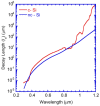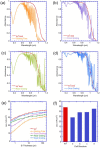Nano-Photonic Structures for Light Trapping in Ultra-Thin Crystalline Silicon Solar Cells
- PMID: 28336851
- PMCID: PMC5295207
- DOI: 10.3390/nano7010017
Nano-Photonic Structures for Light Trapping in Ultra-Thin Crystalline Silicon Solar Cells
Abstract
Thick wafer-silicon is the dominant solar cell technology. It is of great interest to develop ultra-thin solar cells that can reduce materials usage, but still achieve acceptable performance and high solar absorption. Accordingly, we developed a highly absorbing ultra-thin crystalline Si based solar cell architecture using periodically patterned front and rear dielectric nanocone arrays which provide enhanced light trapping. The rear nanocones are embedded in a silver back reflector. In contrast to previous approaches, we utilize dielectric photonic crystals with a completely flat silicon absorber layer, providing expected high electronic quality and low carrier recombination. This architecture creates a dense mesh of wave-guided modes at near-infrared wavelengths in the absorber layer, generating enhanced absorption. For thin silicon (<2 μm) and 750 nm pitch arrays, scattering matrix simulations predict enhancements exceeding 90%. Absorption approaches the Lambertian limit at small thicknesses (<10 μm) and is slightly lower (by ~5%) at wafer-scale thicknesses. Parasitic losses are ~25% for ultra-thin (2 μm) silicon and just 1%-2% for thicker (>100 μm) cells. There is potential for 20 μm thick cells to provide 30 mA/cm² photo-current and >20% efficiency. This architecture has great promise for ultra-thin silicon solar panels with reduced material utilization and enhanced light-trapping.
Keywords: light-trapping; nano-photonics; scattering; solar cell.
Conflict of interest statement
The authors declare no conflict of interest. The founding sponsors had no role in the design of the study; in the collection, analyses, or interpretation of data; in the writing of the manuscript, and in the decision to publish the results.
Figures










References
-
- National Renewable Energy Laboratory (NREL) National Center for Photovoltaics Solar Efficiency Chart. [(accessed on 30 December 2016)]; Available online: http://www.nrel.gov/pv/assets/images/efficiency_chart.jpg.
-
- Green M.A., Emery K., Hishikawa Y., Warta W., Dunlop E.D. Solar Efficiency Tables (version 47) Prog. Photovolt. 2016;24:3–11. doi: 10.1002/pip.2728. - DOI
-
- Atwater H., Polman A. Plasmonics for improved photonic devices. Nat. Photonics. 2010;9:9–16. - PubMed
-
- Palik E. Handbook of the Optical constants of Solids. Academic Press; San Diego, CA, USA: 1998.
LinkOut - more resources
Full Text Sources
Other Literature Sources

